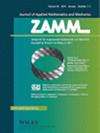Mathematical modeling and analysis for electromagnetohydrodynamic viscous fluid flow with corrugated walls inside a curved channel
IF 3.2
4区 工程技术
Q1 MATHEMATICS, APPLIED
Zamm-zeitschrift Fur Angewandte Mathematik Und Mechanik
Pub Date : 2023-09-11
DOI:10.1002/zamm.202300172
引用次数: 1
Abstract
Abstract The current study considered electromagnetohydrodynamic (EMHD) flow properties on viscid liquid over wavy walls. Initially, performed the scientific evidence and then explanation of velocity attained by applying the perturbation approach. Through mathematical calculations, we evaluated the corrugation impact on EMHD velocity flow. The impacts of evolving constraints from attained solutions are studied by intriguing the diagrams. The significant hypothesis is that decrease the imperceptible wave consequence on the velocity for the minor value of amplitude proportion parameter. For the small value of amplitude, the curvy phenomenon becomes understandable. In graphical results trapped bolus appears for out phase corrugations. From this study, we have come up with the result that the velocity achieves the extreme value in the mid of the channel. The velocity profile declines for the Reynolds number. The reason is that for the greater amount of the Reynolds number, the velocity fluctuates quickly by lesser amplitudes. The velocity profile decay with the growing value of the curving parameter in [−1,0] and grow in [0,1]. The stress components decline and the stress components rise for the curving parameter. The present analysis has practical applications in biomedical propulsion of targeted drug delivery, manufacturing of peristaltic pumps, transportation of diverse fluids.弯曲通道内具有波纹壁面的电磁粘性流体流动的数学建模与分析
摘要本文研究了粘性液体在波浪壁面上的电磁流体动力学(EMHD)流动特性。首先进行了科学论证,然后用摄动法对速度进行了解释。通过数学计算,我们评估了波纹对EMHD速度流的影响。通过绘制图,研究了已得到的解的演化约束的影响。重要的假设是,当振幅比参数值较小时,可减小难以察觉的波对速度的影响。对于较小的振幅值,曲线现象是可以理解的。在图形结果中,出相波纹出现了困丸。从这一研究中,我们得出了速度在通道中部达到极值的结果。随着雷诺数的增加,速度分布减小。这是因为雷诺数越大,速度波动越快,振幅越小。速度剖面随曲线参数在[−1,0]处的增大而衰减,在[0,1]处增大。曲线参数的应力分量减小,应力分量增大。目前的分析在生物医学推进的靶向药物递送、蠕动泵的制造、各种流体的输送等方面具有实际应用价值。
本文章由计算机程序翻译,如有差异,请以英文原文为准。
求助全文
约1分钟内获得全文
求助全文
来源期刊
CiteScore
3.30
自引率
8.70%
发文量
199
审稿时长
3.0 months
期刊介绍:
ZAMM is one of the oldest journals in the field of applied mathematics and mechanics and is read by scientists all over the world. The aim and scope of ZAMM is the publication of new results and review articles and information on applied mathematics (mainly numerical mathematics and various applications of analysis, in particular numerical aspects of differential and integral equations), on the entire field of theoretical and applied mechanics (solid mechanics, fluid mechanics, thermodynamics). ZAMM is also open to essential contributions on mathematics in industrial applications.

 求助内容:
求助内容: 应助结果提醒方式:
应助结果提醒方式:


